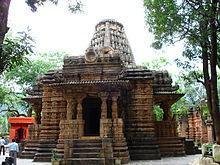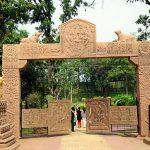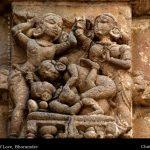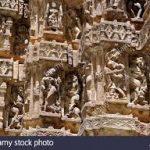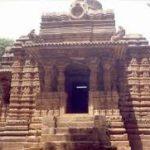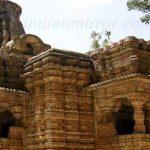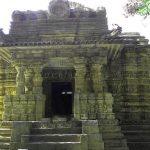Bhoramdeo Temple, Kabirdham ,Chhattisgarh
| Date built: | 1089 AD |
|---|---|
| Deity: | – |
| Architectural style: | Nagara |
| Major festivals | – |
| Locale: | Chaura village, Kawardha town. |
| District:: | Kabirdham |
| Address: | Chhattisgarh 491995 |
| Phone | 08085989809 |
Bhoramdeo Temple is a complex of Hindu temples dedicated to the god Shiva in Bhoramdeo, in the Indian state of Chhattisgarh. It comprises a group of four temples of which the earliest is a brick-temple.
The main temple is the Bhoramdeo temple built in stone. The architectural features with erotic sculptures has given a distinct style akin to the Khajuraho temple and the Konarak Sun Temple in Odisha, and hence the Bhoramdeo complex is known by the sobriquet the “Khajuraho of Chhattisgarh”.
Another temple within a distance of about 1 kilometre (0.62 mi) from Bhoramdeo, which is mentioned along with the Bhoramdeo complex is the Madwa Mahal, meaning marriage hall in local dialect, also known as Dullhadeo. It was built in 1349 during the reign of Ramchandra Deo of the Nagavanshi dynasty and has a unique Shiva Linga erected over 16 pillars.
The temple complex, rich in history and archeological details, is dated to the Kalachuri period (10th-12th centuries, one ruling over areas in Central India in west Madhya Pradesh, Rajasthan and were called Chedi or Haihaya (Heyheya) (northern branch)) with close identity with the sculptures found in nearby archeological sites such as Janjgir, Kalachuri, Narayanpur and Ratanpur sites. The brick temples were built during the rule of Pandus and are similar to those built in Kharod, Palari, Rajim and Sirpur in the state.
The temple complex, highlighted as a “scintillating poetry in stone”, is credited to Nagwanshi Kings who practiced tantrism and who ruled in the then Southern Koshal region, which is now the state of Chhattisgarh. Its construction is dated between the 7th and 12th centuries.As the Gond Tribals of the area worshiped Lord Shiva whom they called Bhoramdeo, the temple was also named Bhoramdeo with the Shiva Linga deified in it.
Architecture
horamdeo temple, built of stone, and dated to the 11th century, which is older than the Khajuraho Group of temples is considered an “outstanding structure”. It has profusion of carved images on its exterior walls. Its architectural style is known as the Gurur type, unlike the north Indian Nagara style of architecture. Its structural uniqueness lies in the receding rows or tiers placed successively upwards in the top part of the temple tower.
The first stage of the temple is a large platform or plinth that is built to height of 5 feet (1.5 m). The platform itself, on its exterior faces, has many sculptures of Hindu deities carved on it.
The temple built over this platform which measures 60 feet (18 m) x 40 feet (12 m) has the conventional Hindu temple composition of a mandapa (hall), followed by an antral or passage leading to the Garbhagriha or sanctum sanctorum, the main enclosure in the temple where the chief deity, Shiva in form of a Shiva Linga, is deified.The mandapa is square on plan and is supported on four main central pillars, apart from the peripheral pillars. The sanctum sanctorum measures 9 feet (2.7 m)x9 feet (2.7 m). All the three enclosures are linked by passageways.
The temple is built facing the eastern direction, where there is an entry door; in addition, there are two more doors which open to the south and north but there is no door in the westerly direction. The three doors have open “half shelters”.
Right at the entrance to the sanctum sanctorum, there are very finely sculpted images of the ten avatars of the god Vishnu, apart from images of Shiva and Ganesha. The towering roof of this garbhagriha is topped by Kalasha, which is circular in shape.The garbhagriha has striking right angled offsets in the north east and southern part which add to the elegance of the temple.There are many small towers which surround the main tower.
The front entrance door of the temple has sculpted images of Ganga and Yamuna on its doorpost.Also sculpted on the exterior and interior walls of the temple are the bass reliefs in the entablature part, of elephants, mythical figures and sensuous sculptures; the sensuous figures on the exterior walls represent the Kama Sutra, the erotic postures which reflects the then prevailing social, cultural, architectural and religious ethos in the region. These sculptures are crafted in three tiers on the exterior face of the temple up to the pinnacle, and are housed in niches. The sculpted images arranged in rows on the outer faces of the main tower vary in size from 1 foot to 1.5 ft to 2 ft in descending order from the top of the tower to its lower end. The main tower expands lower down into four other subsidiary structures to provide stability to the main tower.
The lowest tier of the exterior walls is embellished with sculptures of lions and elephants. The material used for the sculptures are of black and ochre stones (black stone is used to carve pantheon gods while Ochre stone is used for other sculptures). Also sculptured on the exterior face of the temple are divine images of Vishnu and his incarnations. In addition, the entrance doors are flanked by images of mythological figures, which are of 1 or 2 ft in height.On the southern face of the shikara or tower there is well crafted image of Ganesha with six arms and well turned out trunk.Some of the other images of interest are: A stone slab of Vishnu and Lakshmî mounted on Garuda with a king offering prayers, a gana adorning the top part of the pillars; inside the sanctum sanctorum, next to the main deity of Shiva Linga, is serpent with raised hood, and also images of Ganesha and Shiva, and that of a king and queen.
Typical architectural feature which represents the Khajuraho style of architecture is the tower of the temple which is a synthesis of a view of the receding Maikal Hill range. The sharp curved forms, typical of temples of Orissa. are also a built-in feature of this temple.
Legend / Local stories
Photo Gallery
How to Reach:
The Bhoramdeao temple complex is built at the foot of the thickly forested scenic backdrop of the Maikal range of hills, in the Daksina Kosala region, which is in the present day Indian state of Chhattisgarh. It is situated 18 km to the North-West of the tehsil town of Kawardha in Kabirdham district.
The nearest airport to the Bhoramdeo complex is 134 km away near Raipur, which is the capital of Chhattisgarh and Raipur is well connected with the many major cities of the country. Raipur is also the nearest railhead Bombay-Howarah main line. Road communications from Kawardha, the nearest tehsil town to the temple complex, exists to Raipur (116 km), Rajnandgaon(133 km) and Jabalpur(220 km).
There is also a bypass road from Raipur to Madhya Pradesh Highway which skirts the Kanha National Park
Contact Details
Official Address

